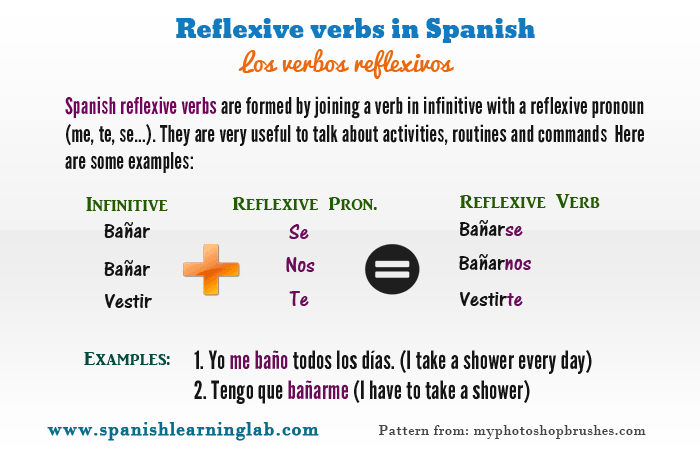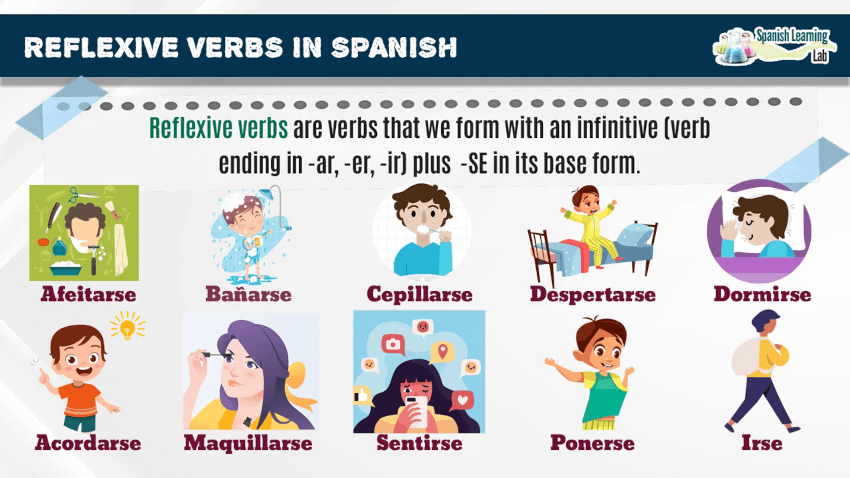“Los verbos reflexivos” or Spanish reflexive verbs are a special type of verbs whose action reflects on the subject. They are often used in everyday conversations, from simple commands to daily activities. This lesson includes a list of common reflexive verbs, the rules to make sentences with them, a great video on this topic and several interactive quizzes to practice this very important topic. Let’s get start…
Video introduction: Reflexive pronouns and verbs in Spanish
This video makes use of nice graphics and several examples to explain what Spanish reflexive pronouns are and their relationship with subject pronouns. It also explains how to conjugate reflexive verbs in the language to make sentences about daily routines and other topics. All the examples in the video will help you get a glimpse on how these verbs work in real life.
How to form reflexive verbs in Spanish – Los verbos reflexivos
As we mentioned in our lesson for regular verbs, Spanish verbs normally end in -AR, -ER and -IR in their infinitive form, and all of them represent an action that usually affects an object. For a very basic sentence like ¨Yo barro el piso¨, YO (I) would be the subject, BARRER (sweep) the action or verb and EL PISO (the floor) the object.
Spanish reflexive verbs work differently, as they represent actions that reflect on the subject of the sentence, not the object itself. Reflexive verbs will not end in -AR, -ER or -IR but in -SE in their base form. It is often a verb in infinitive (part 1) plus the -SE ending (part 2), for example: BAÑAR + SE = BAÑARSE. We could transform any simple verb into a reflexive verb, but it does not make sense to do so for a great deal of them. The picture below shows the structure and two different ways to use them in sentences.

As shown in the video, there are many other common reflexive verbs in the language besides “bañarse” or “vestirse”. Here are some of them:

Conjugating Spanish reflexive verbs: chart and examples
As shown in the picture, reflexive verbs in Spanish are formed by two parts: a verb in infinitive + a reflexive pronoun. If the verb in infinite is regular, it will be conjugated following the rules for its ending, so for a regular verb like BAÑARSE (BAÑAR + SE), we should apply the rules for –AR ending verbs and conjugate the first part of the verb following those rules, and then replace-SE at the end of BAÑARSE with the corresponding reflexive pronoun depending on the subject of the sentence, just as shown in the following sentences:
|
Yo me baño en la mañana
I take a shower in the morning
|
|
Tú te/Vos te – Tú te bañas muy rápido
You bathe very fast
|
|
Él se/ Ella se / Usted se – ¿Ella se baña sola?
Does she bathe by herself?
|
|
Nosotros nos bañamos en el río
We go swimming in the river
|
|
Vosotros os bañáis sin permiso
You take a shower without permission
|
|
Los niños se bañan juntos
The children take a shower together
|
As you can see in the examples, every reflexive pronoun (me, te, se…) is fixed to a specific subject pronoun. This shows when we say “yo me baño” because ME is the reflexive pronoun that corresponds to YO. Leaving out the subject pronoun is totally fine, but do not omit the reflexive pronoun. When talking about reflexive actions, make sure to pair both subject and reflexive pronouns correctly, or they will actually transform into indirect object pronouns, which is a different topic.
Interactive quiz No. 1
Drag and drop the correct forms of each reflexive verb in Spanish to complete these short sentences.
A list of common reflexive verbs in Spanish
Keep in mind that some verbs need a stem change for some pronouns when conjugated, such as “sentir”, “dormir” or “acordar” or “salir”, which is conjugated as SALGO for the pronoun YO so we should say “Yo me salgo” not Yo me salo.. Therefore, besides adding a reflexive pronoun, we must be careful with their conjugation, for example:
- Yo me siento bien. (I feel fine – Saying “yo me sento would be a mistake”.)
- Tú te duermes temprano. (You go to sleep early – Saying “tú te dormes” would be a mistake)
Similarly, there are common irregular verbs like IR (to go) that can sometimes be used in reflexive forms, so again, make sure you conjugate the infinitive correctly as this verb does the rules for regular: “Yo me voy, Tú te vas…”. Take a look at these examples:
- Tú te vas a las 8:00 al trabajo. (You leave for work at 8:00 – Here, we used the irregular verb “IR” in its form “vas”)
- Yo me hago el desayuno. (I cook my breakfast. – Here, we used the irregular verb “HACER”)
There are many reflexive verbs in Spanish to choose from, but we selected some of them and created sentences for you to see their conjugation as well. Make sure you are familiar with all these rules for regular verbs and that you recognize a few basic irregular verbs as well. Listen to the following examples:
|
VESTIRSE – Yo me visto
I get dressed
|
|
DORMIRSE- Tú te duermes
You go to sleep
|
|
ALISTARSE – Él se alista
He gets ready
|
|
PONERSE – Ella se pone el sombrero
She puts on the hat
|
|
QUITARSE – Nosotros nos quitamos el brazalete
We take off the bracelet
|
|
ENCONTRARSE – ¿Ustedes se encontraron con ellos?
Did you meet with them?
|
|
DARSE CUENTA – ¿Ellos ya se dieron cuenta del accidente?
Did they realize about the accident?
|
| FIJARSE – Yo siempre me fijo en los anuncios I always pay attention to the ads |
|
METERSE – Siempre nos metemos en problemas
We always get in trouble
|
| ACORDARSE – ¿Tú te acuerdas de mí? Do you remember me? |
|
ENOJARSE – Él se enojó contigo
He got angry with you
|
|
IRSE – ¿Usted se va con nosotros?
Are you going with us?
|
Interactive quiz No. 2
Read these sentences and write the original form of the reflexive verb in Spanish, for example: *vestirse*
When will you need to use reflexive verbs in Spanish?
Spanish Reflexive verbs can be used to say simple things such as “Yo me baño” or to talk about topics that are a little more complicated like daily routines and hobbies. Here are a few notes to learn how and when to use them:
1. Using Spanish reflexive verbs as the subject of sentences
This happens when we want to use a reflexive verb as the subject of the sentence, for example:
- Ejercitarse es bueno (Exercising is good)
- Despertarse temprano es difícil. (Waking up early is difficult).
- Ayudarnos entre nosotros es lo correcto. (Helping each other is the right thing to do.)
Some verbs will not need a reflexive form such as COCINAR (to cook): Cocinar es mi pasatiempo (Cooking is my hobby). COCINAR is what we would call a non-reflexive verb in the language. Using one or the other depends on what we are trying to say, for example, the sentence “Bañar al perro es divertido” (Bathing my dog is fun) begins with BAÑAR not BAÑARSE because we want the verb to affect the object PERRO (the dog) not everyone in general unlike “Bañarse es divertido” (Taking a shower is fun). In other words, if the action will affect a specific object, then use the verb in infinitive form only with no reflexive pronoun attached.
2. Spanish reflexive verbs for commands
These verbs can also be used for commands or orders such as:
- “¡Ya es hora! ¡Alístate Juan!” (“It’s time! Get ready!”)
- “¡Cómete toda la comida Alex!” (Eat all your food, Alex!)
Here we only conjugate the verb following the rules for Spanish regular verbs and then add the corresponding reflexive pronoun for the person we refer to at the end. Commands are often used for conjugations in the second person so for a verb like BAÑARSE, we would say: “ú báñate, Usted báñese, Vos báñate, Ustedes báñense, Vosotros bañaos“.
We can apply this rule with names instead of the pronouns so for Alex (he), we would say Alex báñate, Alex duérmete, Alex vístete and so on, all of them ending in the reflexive pronoun -TE. It is important to mention that not all commands will need reflexive verbs, for example: ¡Alex estudia! (not Alex estudiate as it would mean Alex study yourself not Alex study!). The verb CÓMETE that we used in the first example, would be used only as COME if we do not have the object LA COMIDA in the sentence: ¡Come Alex! or keeping the object ¡Cómete la comida Alex! Be careful
3. Spanish reflexive verbs for obligations
Finally, we may use reflexive verbs in Spanish to talk about obligations and chores and to do this it is common to use the irregular verb TENER as in:
- Yo tengo que alistarme. (I have to get ready)
- Ellos tienen que irse. (They have to go)
- Tenemos que dormirnos (We have to go to sleep).
The biggest difference in this case is that we keep the verb in infinitive form for all subject pronouns, but change the reflexive pronoun at the end depending on the subject of the sentence.
Interactive quiz No. 3
Read the sentences in this interactive quiz and click on the ones using Spanish reflexive verbs.
Interactive quiz No. 4
Follow the instructions to solve these two grammar exercises about reflexive verbs in Spanish, and then check your answers.
Related Spanish Worksheets:
- Verbs for Daily Routines in Spanish – Crossword Puzzle
- Reflexive Verbs in Spanish – PDF Word Search
- Conjugating Reflexive Verbs in Spanish (Chart + Sentences)
- Daily Activities in Spanish – PDF Worksheet
- My Daily Routine in Spanish
- Messi’s Daily Routine in Spanish – (Reading)
